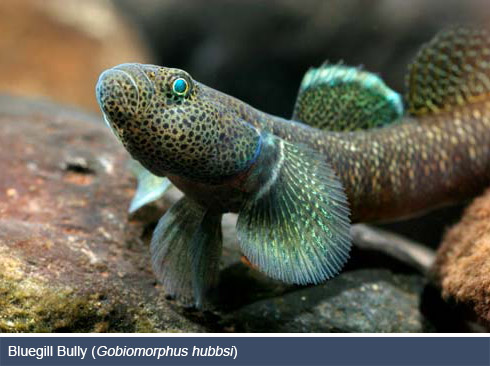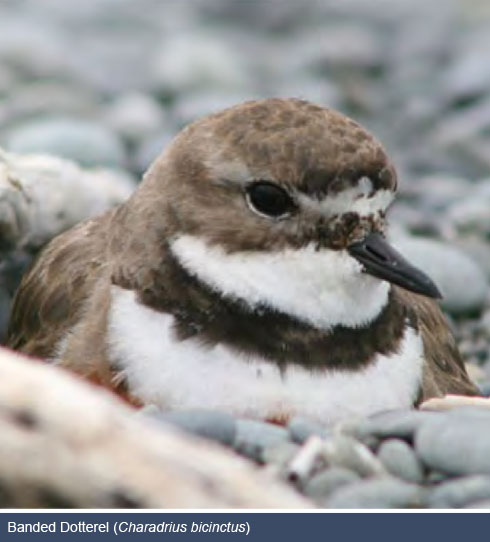

Ecology
The Waipara River supports a variety of life forms and ecosystems, including indigenous plants, birds, aquatic macroinvertebrates, and fish. The Canterbury Regional Council undertakes ecosystem health monitoring on an annual basis at two sites located at Greenwoods (Teviotdale) Bridge and Laidmore Road. This involves sampling macroinvertebrates (small aquatic animals such as insect larvae, worms and snails) as indicators of the health of the aquatic ecosystem, and assessing the quality of the riparian and instream habitat.
Terrestrial vegetation
The upper tributaries of the Waipara River are generally bordered by indigenous grassland and shrubland in addition to a number of indigenous forest remnants some of which are identified in the Hurunui District Plan as Significant Natural Areas. A mix of indigenous and exotic shrubland is regenerating vigorously in many places in the upper tributaries of the river. Indigenous vegetation is limited along the main stem of the Waipara River and its lower tributaries although there are three threatened species present in the area: Isolepis basilaris (in serious decline, in the upper catchment), Muehlenbeckia astonii (nationally vulnerable, in the lower catchment), and Myosurus minimum (nationally endangered, in the lower catchment).
In general, the banks and berms of the Waipara River are predominantly vegetated with exotic plant species including introduced grasses and other low vegetation, shrubs (gorse, broom), and trees (predominantly willows). Many of the dominant plants are spread very effectively by flowing water.
Birds
The Waipara River provides habitat for a number of threatened bird species including the wrybill, black-fronted tern, banded dotterel and bittern. The Waipara River and river mouth were rated in 1983 by the Department of Conservation (O’Donnell and Moore, 1983) to be of “moderate” and “moderate to high” value for wildlife. An assessment by O’Donnell (2000) ranked the river mouth as “High-3” (being of national to international significance for threatened species) and the river as “High-6” (use by <10% of the total population of the threatened species that are present). Use of braided riverbeds by breeding birds occurs principally during late August to January/February.
Aquatic macroinvertebrates
The Canterbury Regional Council has carried out a number of surveys of the river and notes that the aquatic macroinvertebrate species found in the Waipara River are characteristic of Canterbury braided rivers. The most frequently sampled species in the mainstem include mayfly (Deleatidium) and Elmidae larvae. The invertebrate community and habitat are graded as generally only poor to fair, with a tendency for the upstream sampling stations to receive higher gradings. The available data indicates that the aquatic biota in the Waipara River is characterised by species found in a naturally unstable flow regime with long periods of low flow and periodic high flows. Disturbance by periodic high flows tends to produce a faunal community that does not include species that require stable substrates and stable algal covers.
Fish
The indigenous fish species are typical of those present in other Canterbury gravel bedded rivers. Extensive sampling of fish populations indicates that the distribution and density of fish are typical of East Coast South Island river’s with no unusual or rare species.
A survey of 17 sites in the Waipara River undertaken by Richardson and Jowett (1994) identified eight native species, plus brown trout in the river. In the headwaters the native fish population is dominated by upland bullies and common river galaxias, both of which live their entire lives in these freshwater areas. In the lower reaches, mainly torrentfish, bluegill bullies, and common bullies begin to dominate. Shortfin and longfin eels are found throughout the river system. More recent surveys have also found black flounder, lamprey and koaro, and NIWA records indicate that common smelt, Stokell’s smelt and inanga are also present in the river. Of the native species, long finned eels are in gradual decline nationally.
Limited numbers of trout have also been observed in the river, but the Waipara River is not a renowned trout fishery.
Native fish densities are comparable with those in other rivers in the region. Flood flows are particularly important in the Waipara with regard to maintaining an open river mouth. Freshes peaking at about 9m3/s appear to be able to open the river mouth, which permits diadramous native fish to enter the river for spawning. The natural flow regime permits entry of fish during the spawning period in most but not all years. However, there is no evidence that restricted access to the sea, caused by the gravel bar at the mouth, has influenced the abundance of native fish. There are unlikely to be any problems with fish passage in the Waipara River given the fish species present. Eels are the only species found in the upper catchment that migrate and because of their ability to travel in small volumes of water, either as downstream adult migrants or juveniles moving upstream, low flows are unlikely to restrict movement.

